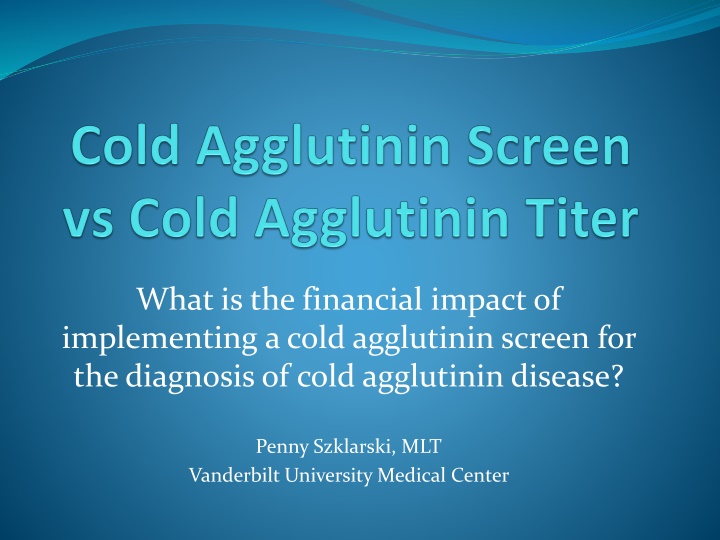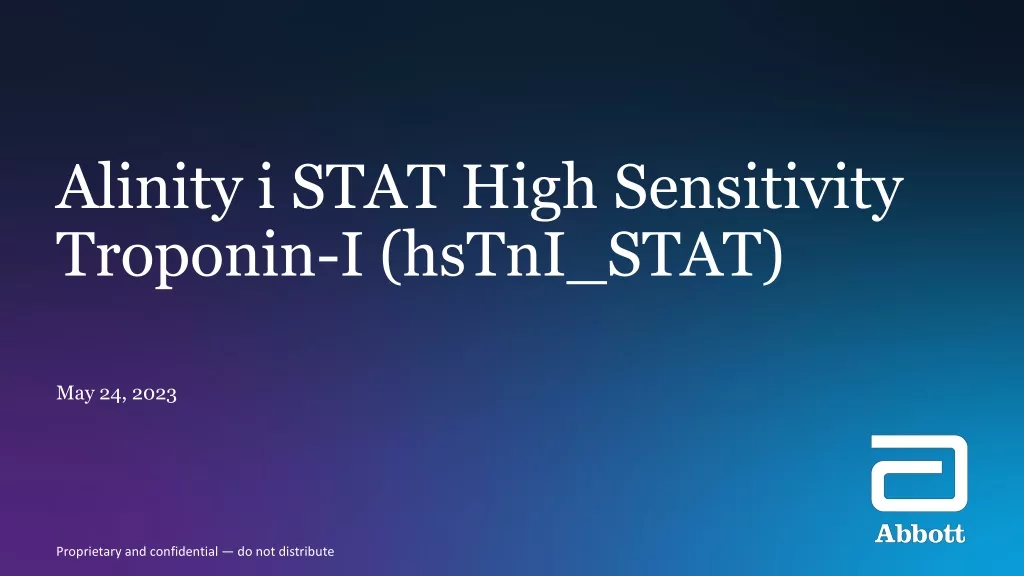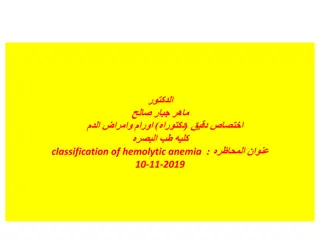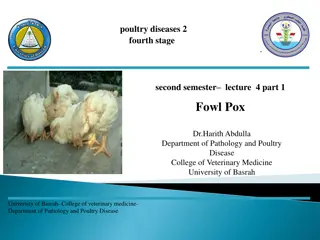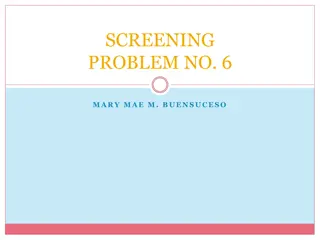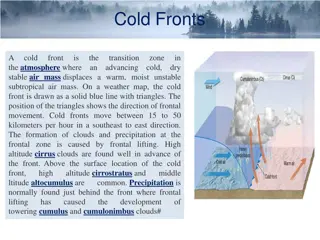Financial Impact of Cold Agglutinin Screen for Diagnosis of Cold Agglutinin Disease
Cold agglutinin disease, a rare form of autoimmune hemolytic anemia, accounts for 15% of AIHA cases. Implementing a cold agglutinin screen for diagnosis can have significant financial implications in healthcare costs. This condition is characterized by the presence of cold agglutinins, primarily IgM antibodies, which can lead to hemolysis. Understanding the financial impact of screening can aid in the management of patients with this condition.
Download Presentation

Please find below an Image/Link to download the presentation.
The content on the website is provided AS IS for your information and personal use only. It may not be sold, licensed, or shared on other websites without obtaining consent from the author.If you encounter any issues during the download, it is possible that the publisher has removed the file from their server.
You are allowed to download the files provided on this website for personal or commercial use, subject to the condition that they are used lawfully. All files are the property of their respective owners.
The content on the website is provided AS IS for your information and personal use only. It may not be sold, licensed, or shared on other websites without obtaining consent from the author.
E N D
Presentation Transcript
What is the financial impact of implementing a cold agglutinin screen for the diagnosis of cold agglutinin disease? Penny Szklarski, MLT Vanderbilt University Medical Center
Anemia The World Health Organization defines anemia as a hemoglobin level less than 13 g/dl in men and less than 12 g/dl in premenopausal, nonpregnant women. AABB Technical Manual 18thEdition
Autoimmune Hemolytic Anemia (AIHA) Warm AIHA Cold agglutinin disease Mixed-type AIHA Paroxysmal cold hemoglobinuria AABB Technical Manual 18thEdition
What is Cold Agglutinin Disease? Cold Agglutinin Disease is rare and accounts for 15% of patients with autoimmune hemolytic anemia (AIHA) Blood, 15 August 2013 Volume 122, Number 7
Polyclonal Antibodies Monoclonal Antibodies Typically seen in post infectious setting Most commonly seen in pediatrics Mycoplasma Long term disease Often resists treatment May be associated with an underlying lymphoproliferative disorder Seen in geriatrics Blood, 15 August 2013 Volume 122, Number 7
Wright Stain Blood Smears Normal Cold Agglutinin Disease
Wright Stain Blood Smears Normal Cold Agglutinin Disease
Specimen tubes from a patient with cold agglutinin disease Photo complements of Dr. Garrett Booth, Vanderbilt University Medical Center
Primary Study Hypothesis Was the assumption correct that providers were ordering cold agglutinin titers instead of cold agglutinin screens?
Research Methodology Institutional Review Board (IRB) approval was obtained. Retrospective chart review was performed Titers from 1/1/2010 to 10/31/2013 Screens from 4/2012 to 10/31/2013 Cold agglutinin titers of >1:64 were considered clinically significant
Limitations Ordering provider s field of expertise Small sample size due to the rarity of the disease
What is the most cost effective blood bank test for the diagnosis of cold agglutinin disease?
Cold agglutinin titer Titers are performed at 4 C Low titers of cold agglutinins can be found in normal individuals
How common is cold agglutinins in blood donors? A recent study revealed that 5% of donors tested for cold agglutinins had titers of >1:4 Retrospective review of 276 healthy donors (2014 Transfusion, 54: 1294-1297
Cold agglutinin screen IgG and C3d Direct Antiglobulin Test (DAT) Room temperature and 30 C saline antibody screens with auto controls Thermal amplitude if positive *Immune Hemolytic Anemias Second Edition Lawrence D. Petz, MD George Garratty, PhD
Diagnostic for Cold Agglutinin Disease 70% of all clinically significant cold agglutinins react at 37 C 100% of all clinically significant cold agglutinins react at 30 C Positive C3D and Negative IgG DAT Positive RT and 30 C saline antibody screen with positive auto controls Immune Hemolytic Anemias-Second Edition , Dr .Lawrence Petz and Dr. George Garratty
Results: Cold Agglutinin Titer 80 Titers were ordered prior to inception of the screen 5 (6.3%) were clinically significant 2 were diagnosed with Stevens-Johnson Syndrome 1 was diagnosed with B-Cell Lymphoma 2 were newly diagnosed with Cold Agglutinin Disease 68 (85%) had a negative C3d
Why is a negative C3d significant? Cold agglutinin disease is strongly supported with a positive C3d and a negative IgG DAT
Results: Cold Agglutinin Screen 17 Cold agglutinin screens were ordered. 7 (41%) were positive requiring thermal amplitude 3 (17.6%) diagnosed with cold agglutinin disease 1 diagnosed with Systemic Lupus Erythematosus 1 diagnosed with Myelofibrosis 2 were outpatients and lost to follow-up
Since implementation of the cold agglutinin screen. 38 Titers were ordered independent of the screen 3 (7.8%) were true positive with titers of >1:64
What are the financial implications of ordering titers instead of screens for diagnosis?
Cost Analysis Cold Agglutinin Titer Cold Agglutinin Screen Consumables Cost per Unit Units Total 10X75 Tubes $ 0.02 1 $ 0.02 Consumables Cost per Unit Units Total 12x75 Tubes $ 0.06 1 $ 0.06 10X75 Tubes $ 0.02 11 $ 0.22 MTS Gel Card $ 0.80 1 $ 0.80 C3d Reagent $ 1.34 1 $ 1.34 Screen Cell 1 $ 0.49 10 $ 4.90 Total Total Consuma Consuma bles $ 2.22 bles $ 5.12 Salary and Benefits Hrly Rate Hrs Total Salary and Benefits Hrly Rate Hrs Total Tech Time $ 31.25 0.48 $ 15.10 Tech Time $ 31.25 0.35 $ 10.94 Total Cost per Test $ 17.32 Total Cost per Test $ 16.06
Positive Pretest Probability 6.3% using the titer 17.6% using the screen
Cost of inappropriately ordered tests 38 Independently ordered titers 35 (92.1%) rendered no new cold agglutinin disease diagnosis at a cost of $562.10
Conclusion Cold agglutinin disease is rare Knowledge of correct test for diagnosis is essential Inappropriate testing cost money Inappropriate testing takes time away from more important projects
Acknowledgements Garrett Booth, M.D., Associate Medical Director Allison Paroskie, M.D, Associate Medical Director Emily Coberly, M.D., Transfusion Medicine Fellow Stephanie Sephel, MLS, SBB, Transfusion Medicine Manager Mary Johnson, MLS, SBB, Transfusion Medicine Supervisor The entire Vanderbilt Transfusion Medicine Staff
